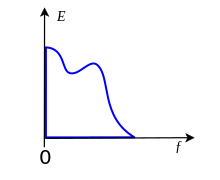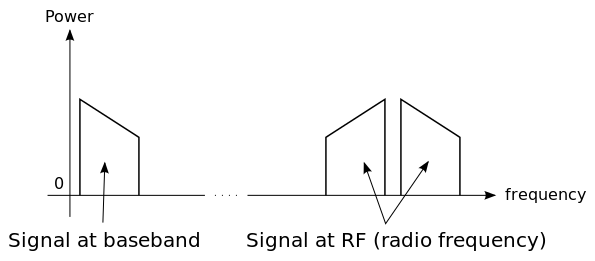Baseband
Baseband is a signal that has a near-zero frequency range, i.e. a spectral magnitude that is nonzero only for frequencies in the vicinity of the origin (termed f = 0) and negligible elsewhere.[1] In telecommunications and signal processing, baseband signals are transmitted without modulation, that is, without any shift in the range of frequencies of the signal.[2] Baseband has a low-frequency—contained within the bandwidth frequency close to 0 hertz up to a higher cut-off frequency. Baseband can be synonymous with lowpass or non-modulated, and is differentiated from passband, bandpass, carrier-modulated, intermediate frequency, or radio frequency (RF).

Various uses
Baseband signal
A baseband signal or lowpass signal is a signal that can include frequencies that are very near zero, by comparison with its highest frequency (for example, a sound waveform can be considered as a baseband signal, whereas a radio signal or any other modulated signal is not).[3]
A baseband bandwidth is equal to the highest frequency of a signal or system, or an upper bound on such frequencies,[4] for example the upper cut-off frequency of a low-pass filter. By contrast, passband bandwidth is the difference between a highest frequency and a nonzero lowest frequency.
Baseband channel
A baseband channel or lowpass channel (or system, or network) is a communication channel that can transfer frequencies that are very near zero.[5] Examples are serial cables and local area networks (LANs), as opposed to passband channels such as radio frequency channels and passband filtered wires of the analog telephone network. Frequency division multiplexing (FDM) allows an analog telephone wire to carry a baseband telephone call, concurrently as one or several carrier-modulated telephone calls.
Digital baseband transmission
Digital baseband transmission, also known as line coding,[6] aims at transferring a digital bit stream over baseband channel, typically an unfiltered wire, contrary to passband transmission, also known as carrier-modulated transmission.[7] Passband transmission makes communication possible over a bandpass filtered channel, such as the telephone network local-loop or a band-limited wireless channel.
Baseband transmission in Ethernet
The word "BASE" in Ethernet physical layer standards, for example 10BASE5, 100BASE-TX and 1000BASE-SX, implies baseband digital transmission (i.e. that a line code and an unfiltered wire are used).[8][9]
Baseband processor
A baseband processor also known as BP or BBP is used to process the down-converted digital signal to retrieve essential data for the wireless digital system. The baseband processing block in GNSS receivers is usually responsible for providing observable data: code pseudo-ranges and carrier phase measurements, as well as navigation data.
Equivalent baseband signal
An equivalent baseband signal or equivalent lowpass signal is—in analog and digital modulation methods for (band-pass) signals with constant or varying carrier frequency (for example ASK, PSK QAM, and FSK)—a complex valued representation of the modulated physical signal (the so-called passband signal or RF signal). The equivalent baseband signal is where is the inphase signal, the quadrature phase signal, and the imaginary unit. In a digital modulation method, the and signals of each modulation symbol are evident from the constellation diagram. The frequency spectrum of this signal includes negative as well as positive frequencies. The physical passband signal corresponds to
where is the carrier angular frequency in rad/s.[10]
Modulation
A signal at baseband is often used to modulate a higher frequency carrier signal in order that it may be transmitted via radio. Modulation results in shifting the signal up to much higher frequencies (radio frequencies, or RF) than it originally spanned. A key consequence of the usual double-sideband amplitude modulation (AM) is that the range of frequencies the signal spans (its spectral bandwidth) is doubled. Thus, the RF bandwidth of a signal (measured from the lowest frequency as opposed to 0 Hz) is twice its baseband bandwidth. Steps may be taken to reduce this effect, such as single-sideband modulation. Some transmission schemes such as frequency modulation use even more bandwidth.
The figure shows what happens with AM modulation:

See also
| Look up baseband in Wiktionary, the free dictionary. |
- Complex envelope
- Broadband
- In-phase and quadrature components
- Narrowband
- Wideband
References
- Leon W. Couch II (1993). Digital and Analog Communication Systems. Prentice Hall.
- B.P. Lathi (1983). Modern Digital and Analog Communication Systems. Holt, Rinehart and Winston.
- Steven Alan Tretter (1995). Communication System Design Using Dsp Algorithms: With Laboratory Experiments for the TMS320C30. Springer. ISBN 0-306-45032-1.
- Mischa Schwartz (1970). Information, Transmission, Modulation and Noise: A Unified Approach to Communication Systems. McGraw-Hill.
- Chris C. Bissell and David A. Chapman (1992). Digital Signal Transmission. Cambridge University Press. ISBN 0-521-42557-3.
- Mikael Gustavsson and J. Jacob Wikner (2000). CMOS Data Converters for Communications. Springer. ISBN 0-7923-7780-X.
- Jan W. M. Bergmans (1996). Digital Baseband Transmission and Recording. Springer. ISBN 0-7923-9775-4.
- IEEE 802.3 1.2.3 Physical layer and media notation
- "IEEE Get Program". standards.ieee.org. IEEE. Retrieved 29 March 2017.
- Proakis, John G. Digital Communications, 4th edition. McGraw-Hill, 2001. p150